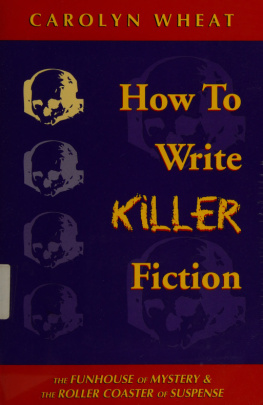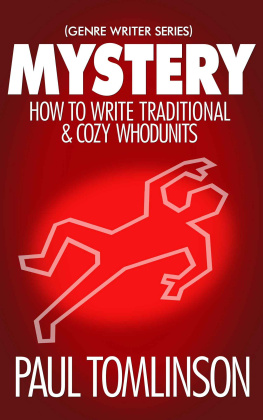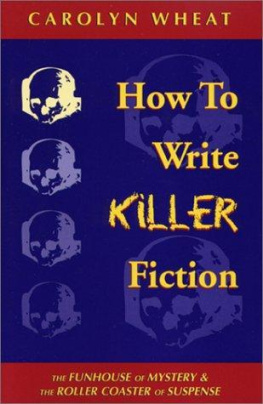You Can Write a Mystery!
Books, movies, TV shows, video gamesmysteries can be found everywhere, for every type of audience. Part story, part puzzle, mysteries are naturally fun and exciting, both to read and to write. But how do you begin to write a mystery story? In Write a Mystery in 5 Simple Steps, author Amy Dunkleberger shows aspiring writers how to invent a believable mystery.
This step-by-step guide offers practical advice that all aspiring mystery writers should read. With various tips and clever exercises, Write a Mystery in 5 Simple Steps is an impressive resource.
Brianne L. Johnston, English teacher & Department Head, MCPS
About the Author
A native of Washington, D.C., Amy Dunkleberger earned a BA in English from Reed College and graduate degrees from New York University and the American Film Institute. She has written about writing and the dramatic arts for many years, and in 1994, she won an Emmy Award for her CBS teleplay Other Mothers. She now resides in California.

Was it Professor Plum in the kitchen with the candlestick? Or Colonel Mustard in the conservatory with the wrench? Chances are, you know these colorful characters from the Clue mystery game. Chances are, Clue is only one of many mysteries you have already experienced in your life.
Books, movies, TV shows, video games mysteries can be found everywhere, for every type of audience. Part story, part puzzle, mysteries are naturally fun and exciting, both to read and to write.
But how do you begin to write a mystery story? Perhaps you have heard the adage write what you know and wondered how you could know enough to invent a believable mystery.
Mysteries can be full-length novels (usually more than 140 pages), short stories (usually less than 30 pages), and any length in between. Regardless of length, all stories begin with an original idea, a spark that starts the creative fire. The idea might come in the form of a character or an event. In the case of mysteries, the character will likely be a detective of some sortthe person who solves the mysteryand the event will be a crime.
But where do you find inspiration for these original ideas? Your muse, or source of inspiration, can come from many places. Music, paintings, news articles, dreams, and your own life experiences can spur ideas. Inspiration can come in an apparent flash, as it did for author Jacqueline Winspear, creator of the Maisie Dobbs mystery series: I was inspired to write my first novel, Maisie Dobbs, by the character herself, who appeared in my minds eye as I allowed my imagination to wander while stuck in traffic. By the time I started my car to drive home, I had the entire story in my head.

When coming up with ideas for stories, many writers look to their own lives for inspiration. Caroline Lawrence used her background in archaeology as the jumping-off point for her Roman Mysteries series. Newspaper reporter John Feinstein mined his knowledge of sports to come up with his sports-themed mystery series. Experiences in a specific activity, such as sports and special-interest clubs, can be an excellent source for story ideas. They can also provide a good arena around which to build a tight story.
Some authors have developed special techniques for zeroing in on story ideas. In an online interview, childrens writer Nancy Springer, for example, revealed that she finds inspiration by talking with strangers: I will start strange conversations just to see what people will say. Almost always, theyll come up with something that I never would have thought of.
R. L. Stine, author of the Goosebumps, Nightmare Room, and Fear Street series, refers to his sources of inspiration as his idea store. Stine divides his store into three departmentsthe experience department, the memory department, and the what if or wonder department.
For experience ideas, Stine starts with everyday activitiesa bus ride or a trip to the movies, for exampleand finds ways to twist these ordinary actions into a compelling story. Observation is a key element of experience ideas. The more the writer notices, the more material he or she will have for forming fresh ideas.
Stines memory ideas come from recollections of people and art that have lingered in his imagination. A lyric in a song or a past conversation with a friend might provide the perfect jumping-off point for a story. Being true to the memory is not important. Once it has inspired you, you can change it to suit your creative needs.
Stines what if or wonder ideas begin with a question: What would happen if ? The opening line of Stines Fear Street mystery The Confession is a perfect example of a what if idea: What would you do if one of your best friends took you aside and confessed to you he had killed someone?
As the story unfolds, Stine answers all the questions he poses. But knowing all the answers to what-if questions in advance is not crucial to devising a solid story idea.
You may not always be aware of the creative process going on in your head, but you will recognize the results when they happen. According to Springer, Ideas usually come just a little bit at a time a whiff in the air, something that zips past. You have to grab it. Sometimes, its just a feeling, an emotion, a picture in your head.

Mystery stories have been around for a long time. Some historians trace the origins of the mystery genre all the way back to ancient Greece and Rome. Modern mysteries emerged in the 1800s, after such cities as Paris, New York, and London had formed large-scale police forces.
American author Edgar Allan Poe (18091849) is considered the father of modern mystery writing. His 1841 short story The Murders in the Rue Morgue introduced readers to Auguste C. Dupin, fictions first crime-solving detective. Other early mystery writers include English author Wilkie Collins (18241889) and American writers Louisa May Alcott (18321888) and Anna Katharine Green (18461935). Ebenezer Gryce, the hero of Greens 1878 novel The Leavenworth Case, was the first fictional detective created by a female writer.
Beginning in the late 1800s, Sir Arthur Conan Doyle (18591930) took mystery fiction to the next level with his still-popular Sherlock Holmes series. Doyle crafted great stories, but his main achievement was the creation of Holmes, his brilliant and resourceful private detective.
The early twentieth century marked the next great wave of mystery fiction. Agatha Christie (18901976), the queen of crime, wrote the first of her eighty-plus novels in 1920.
Christie was soon joined by fellow English author Dorothy L. Sayers (18931957) and American writer S. S. Van Dyne (18881939), among many others. Around the same time, the Nancy Drew and Hardy Boys series became the first mysteries written expressly for teens.
Like Doyle, Christie and Sayers specialized in cozy mysteries. In cozies, the crime has already been committed when the story begins, and the story contains little or no violence. Often the crimes occur in isolated locations, such as a cruise ship or a mansion. Cozies are almost always whodunitsstories in which the identity of the criminal is unknown until the end.















